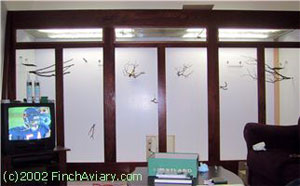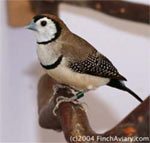|
|
Perches
Number
of Perches | Perch Diameter | Perch
Placement | Types of Perches
The
type, shape, and arrangement of perches will help mold your
bird's experiences. They will spend most of their time on
a perch, whether sleeping, resting, hopping about, snuggling,
preening, mating, snacking, or investigating. Because perches
are such an integral part of the birds' daily lives, I try
to offer as much variety as possible. Variety can be provided
via perch thickness, perch type, perch angle, perch height,
perch location, perch direction, and perch mobility.
Number
of Perches
|
Click
on the photo to enlarge. Notice the flight
space provided between perches to encourage
exercise. (This picture was taken before
the aviary was completed).
|
|
I've heard that for each bird you need at least 3"
of perch space. That's a bare minimum. I like to keep
close to one perch or one branch of a perch for each
bird. I believe that the birds need to be able to get
away from each other from time to time, and having a
whole perch to yourself can be necessary on occasion.
Too
much of a good thing can be a bad thing, however. A
cage or aviary that is overcrowded with perches discourages
or inhibits flight. If a bird can travel from one end
of the cage to the other by hopping from branch to branch,
there are too many perches in the aviary. It is important
to encourage flight and therefore exercise by providing
areas of empty space between perches. (The exceptions
to this rule would be in the case of a handicapped bird
that has difficulty flying, young fledglings who have
not built up their flight muscles yet, and sometimes
newly acquired birds who have been raised in a small
cage and therefore never have had the opportunity to
fly or build those muscles. Enough perches should be
provided for him or her to get to the desirable places:
a sleeping spot, a millet spray, a cuttlebone, etc.)
|
Perch
Diameter
|
Ideally,
the perch should be thick enough that the
bird cannot get its whole claw around the
perch.
|
|
Providing perches of varying thickness will help exercise
the muscles in the birds' feet. Ideally, the perches
should be thick enough that the bird cannot get its
whole claw around the perch. However, I fail to meet
this ideal in numerous places (the clothesline, the
sundecks, and the smallest ends of some of the manzanita
perches). I do feel, however, that the benefits of these
different types of perches outweigh the disadvantages,
since there are also numerous perches available of greater
thickness. The optimum perch diameter range for finches,
in my opinion, is between 1/4" and 5/8".
|
Perch
Placement
|
Most
of the perches are positioned at about the
same height, with space above for flight.
While in this photo it appears that the
perches are very close together, that is
an illusion. In the photo labeled Number
of Perches above, you can see that there
really is plenty of space between perches
to encourage flight.
|
|
I like to position the perches in groups, with gaps
between the groups. This allows the birds to hop around
within a perch group, but requires them to fly to arrive
at a different group.
Perches
should be positioned carefully. When avoidable, a perch
should not be placed directly beneath another perch
(to stay out of the line of fire of droppings) and also
should not be positioned above a food or water receptacle.
If this is unavoidable, some type of roof or shield
should protect the food and water from being soiled
from above (this is a good idea anyway, as it will also
protect against contamination from fly-by droppings).
Because
the birds will undoubtedly prefer the highest perches,
the majority of the perches should be placed at this
high level, with only a few at significantly lower positions.
If you place too many perches down low, you will most
likely find that many of your perches are neglected
by the birds, in favor of the higher, more favored locations.
This is particularly true for nestboxes. The higher
the nestbox, the more desirable it will be. Placing
nestboxes at mixed heights will likely incur fighting
over the highest boxes. To avoid this, place all nestboxes
at or near the same height in the aviary. I don't use
nestboxes, but I do provide bird sundecks, which many
of my birds chose to use as sleeping places. All sundecks
are positioned at the same height to discourage territory
disputes.
While
I recommend placing most perches higher up, some perches
lower down are still necessary. An injured or sometimes
even a molting bird may have difficulty reaching the
high perch level. Also, new additions that have never
been exposed to a spacious aviary may not have the muscle
strength to fly high enough to reach even the lowest
perches. The reverse can also be true. New additions
who can successfully reach the perches may be leery
of flying down to the bottom where the food is (but
where they may feel more vulnerable). However, the availability
of perches lower down will allow such birds to venture
down in gradual increments, where they can further investigate
without feeling so vulnerable.
I
tend to hang the cuttlebone and the millet at perches
that are not used as frequently. This will encourage
the birds to get some use out of the less popular perches
(the attraction of millet spray is much stronger than
the attraction to a higher perch). It also keeps birds
who are not interested in eating out of the way of the
birds who are. I try to position millet spray near a
multi-branched perch so multiple birds can eat at the
same time. I also position the sandy perches at the
highest locations in the perch zone to encourage frequent
use (in the hope that nails will be kept trim without
needing clipping).
I
like to provide obstacle-free flight paths in my aviary.
This means leaving at least 1.5 feet of perch-free space
at the top of the aviary to be used for flight laps
across the aviary (the clothesline swinging perches
are the exception, since they must attach to the top
of the aviary). (I also like to hang the clothesline
perches parallel to the aviary front for best viewing
of the "birds on a wire" phenomenon.) In addition,
most of the perches are located close to the back wall
so that the front of the aviary is open for flight.
|
Types
of Perches
The
following types of perches can be found in my aviary:
4
Large Complex Multi-Branched Manzanita Perches
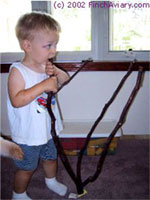 |
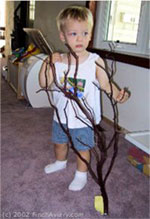 |
|
Zach
models the large manzanita perches for
me. Apparently, they make good teethers
too!
|
|
Natural
branches are the best perches for the birds, offering
limbs of varying diameters and angles. Branches can
be collected from the outside and used as perches if
sanitized properly. I have heard that baking for 10
minutes in a 350 degree oven will do the trick. Disinfecting
with a bleach solution may be in order as well.Instead
of collecting branches from the outdoors, I use the
manzanita perches available from pet stores. These are
made from natural manzanita branches, come in varied
shapes and sizes, and include a bolt and nut for easy
attachment to cage and aviary walls. While manzanita
has a smooth bark and thus is not ideal for keeping
nails trim, it is very easy to clean, having few ridges
and crevices where poop can become embedded.I purchased
4 very large and branchy manzanita perches from a local
bird fair. The most expensive was only $7.50, the equivalent
of some of the smaller versions available in pet shops.
Three of the four were too branchy to be used as is.
The network of little branches were quite dense, which
would make it difficult for the birds to access many
of the limbs and making it near impossible to clean.
Plus, many of the branches were way too thin to be suitable
perches (even in my aviary, where thin perches are permitted).
Thus, I had to prune them down to a more reasonable
density. |
Pet Store Variety Manzanita Perches
 This
is a typical pet store manzanita perch.
They can be acquired as branched perches
like this one, or straight, single branch
perches.
This
is a typical pet store manzanita perch.
They can be acquired as branched perches
like this one, or straight, single branch
perches. |
|
In
addition to the more complex manzanita perches discussed
above, I also use a number of smaller manzanita perches
purchased from the local PetSmart. I purchased 10, but
only saw the need for a few once the aviary was built.
This type of perch is available at most pet stores that
sell bird supplies. |
Sandy Perch
 A
Sandy Perch
A
Sandy Perch |
|
I
also have 2 finch-sized Sandy Perches purchased from
LadyGouldianFinch.com.
When the aviary was first built, one was installed
in the aviary. LadyGouldianFinch.com
is the only site (to my knowledge) that offers these
perches in a finch-appropriate diameter. They are
basically manzanita branches with a colored sand bonded
to them. They are supposed to help keep nails trim
without causing the pressure sores associated with
sand-paper or concrete perches.I gave the Sandy Perches
a try because some of my strawberries have nails that
can grow out of control. Most of the other birds have
not had a problem with this. I had hopes that the
Sandy Perches would decrease the number of times the
strawberries needed to be caught for nail trimming.
Unfortunately,
they were very difficult to keep clean. The rough
texture allowed droppings to embed between sand particles,
and scrubbing and dishwashing could not get them clean
again. I didn't really notice much of an improvement
with regard to the strawberries' nails, so I replaced
the Sandy Perch with a fir perch (similar to manzanita
perches but with a coarser bark). Perhaps the strawberries
did not use the perch enough, I don't know. I didn't
have much luck with it. If you choose to use Sandy
Perches, do not use them exclusively. In addition
to being expensive, I believe that too much exposure
is not good for a bird's feet.
|
Clothesline Perch
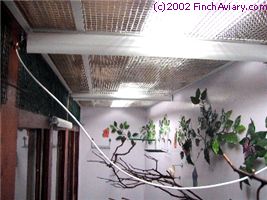 Plastic
clothesline was installed across the depth
of the aviary to create a swinging perch.
It is a favored spot of my blue-caps.
Plastic
clothesline was installed across the depth
of the aviary to create a swinging perch.
It is a favored spot of my blue-caps. |
|
A
swinging perch was made from plastic clothesline,
attached at both ends to the aviary wall/front near
the ceiling. Swinging perches provide good exercise
for a bird since they must maintain their balance
as the clothesline moves. Plastic clothesline was
used instead of cloth/rope clothesline so that nails
would not become entangled in rope fibers and so cleaning
would be easy. The drawback to these swinging perches
is that the clothesline is not quite as thick as I
would like it to be.
Alternatively, swings can be purchased from pet stores.
I preferred the clothesline approach because it allows
more birds to swing at a time.
|
Numerous
Bird Sundecks
 Bird
sundecks - Jade (left) and Evel (right)
sleep on this sundeck every night. The
male societies and Bucky the pied zebra
also favor the sundecks.
Bird
sundecks - Jade (left) and Evel (right)
sleep on this sundeck every night. The
male societies and Bucky the pied zebra
also favor the sundecks. |
|
Bird
sundecks were obtained from Hornbeck's (now owned
by Drs Foster
and Smith). These sundecks are provided to my
birds for use as a non-breeding sleeping spots in
place of nestboxes. Without nesting material, it is
impossible for a bird to lay and incubate eggs on
the sundeck. It is, however, a more comfortable place
to sleep than a single perch (well, atleast, I would
think it is, never having slept on one myself). And
it is also very easy to clean. My societies, zebras,
and masked grass finches have all chosen to use a
sundeck as their sleeping place in lieu of having
a nestbox.
Although
the sundecks are all placed at the same height (relatively
high), they are not the highest perches in the aviary.
This is because I want to discourage their use as
a perch during the day, since the bars they are built
from are not very thick. Also, I am starting out by
including more sundecks than would be needed (so that
everyone can pick their chosen location). But once
everyone has claimed a sleeping spot, I will remove
the other unclaimed sundecks to encourage use of regular
perches during the day.
|
Other
Perch Types (not used by me) include the following
Dowel
Rod
Dowel
rods are also frequently used as perches, most often in
cages, but also in aviaries in the form of a swing, a hanging
rod with dowel perches sticking out, or a parrot play gym
that sits on the floor. I don't use dowel perches because
I find them hard to clean. Were I to use a dowel perch,
I might try painting it with a gloss or semi-gloss paint
first (latex-based), in an effort to make clean-up easier.
Rope
Another
common perch type is a thick braided rope perch. I prefer
not to use rope perches because nails can become caught
in the fibers and because poop can become embedded in the
strands, making it less sanitary.
Plastic
Perches
I
don't use plastic perches because I don't believe they are
a good surface for bird feed. However, plastic perches are
easy to clean and can be sanitized in a dishwasher. Plastic
perches should not be used as the sole perch type in the
cage or aviary.
Sandpaper
or Concrete Perches
Sandpaper
and concrete perches are used to help keep a bird's nails
trim. However, they can cause pressure sores on the birds'
feet. In my experience, concrete perches are generally preferred
over sandpaper perches; but sandpaper perches frequently
make use of a sandpaper cover that can be replaced regularly,
making clean-up easy. If used, there should really only
be one (or two if the aviary is spacious) such perches and
they should be the highest perches available. I have tried
Sandy Perches instead, but found them too difficult to keep
clean and not as effective as I had hoped.
Natural
or Artificial Plants
Another
excellent source of perches are natural or artificial plants.
If natural plants are used, first check to ensure that they
are on the safe
plants for birds list. Artificial plants are safe to
use around birds, but plastic branches are not as good for
the birds as natural ones. Plastic plants can also be a
challenge to clean. For this reason, the artificial greenery
is limited inside my aviary.
Click
Previous to return to the Accessories Index | Click Next for
the Food and Water Containers page
PREVIOUS  |
|  NEXT
NEXT
 TOP TOP
|
|
|
|
Remember,
click on any picture to enlarge it. All pictures embedded in the
pages are displayed at small sizes to improve download times.
|
|
